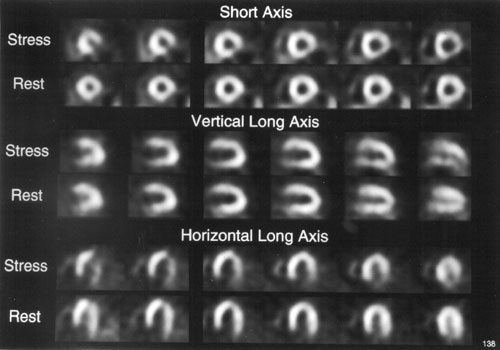- Which of the following radiopharmaceuticals has the highest myocardial extraction fraction?
- Thallium-201
- Technetium-99m-sestamibi
- Technetium-99m-pyrophosphate
- Technetium-99m-tetrofosmin
- For which of the following is myocardial perfusion imaging most appropriate?
- Risk assessment after acute myocardial infarction
- Screening of asymptomatic middle-aged men
- Evaluation of patients with premature ventricular beats
- Diagnostic assessment of patients with right bundle branch block
- A patient with severe obstructive pulmonary disease is referred for a stress study to evaluate an atypical chest pain syndrome.The patient is on a therapeutic regimen including both oral theophylline and nebulizers. The most appropriate stress agent would be:
- dipyridamole
- adenosine
- dobutamine
- exercise
- Which of the following patients would be best managed by a conservative approach following an acute myocardial infarction?
- A 57-year-old male with a fixed perfusion defect and LVEF of 52 %
- A 71-year-old female who completed six minutes of a modified Bruce exercise protocol with a reversible lateral perfusion defect
- A 64-year-old male treated with thrombolytic therapy with exercise-induced ST depression, a small fixed inferolateral defect and a moderate reversible anteroseptal defect
- A 56-year-old female who had a recurrence of her angina at rest post inferior myocardial infarction

The quality and size of the above illustration is not representative
of the figures which will be included on the examination.
- The stress-rest Tc-99m Sestamibi SPECT images shown above were obtained on a 57-year-old male who complained of recurrent exertional chest pain 4 months after triple bypass surgery. The patient exercised for a total of 7 minutes using the Bruce protocol. He developed mild chest discomfort but stopped exercising because of fatigue. Which of the following interpretations is most appropriate?
- There is a fixed defect representing perioperative myocardial infarction
- There is ischemia in the distribution of the left circumflex artery
- There is an infero-basal attenuation artifact on the stress images
- The study shows a motion artifact
- A reversible perfusion defect is most likely to occur in the absence of coronary stenosis in which of the following clinical situations?
- Right axis deviation
- Right bundle branch block
- Hypertrophic cardiomyopathy
- Hypertension
- If the count rate is measured as 1000 cps two feet away from a point source, what would the count rate be at one foot away from an uncollimated gamma camera?
- 1,000 cps
- 2,000 cps
- 4,000 cps
- 6,000 cps
- Radionuclide imaging to assess myocardial viability is appropriate for which of the following patients?
- A patient three days after a non-Q wave myocardial infarction having recurrent chest pains accompanied by transient ST depressions
- A patient with left ventricular ejection fraction of 25% with triple vessel disease hospitalized with congestive heart failure
- A patient with a fixed inferior perfusion defect but normal left ventricular function on gated SPECT
- A patient with primary dilated cardiomyopathy
- Acquisition of an adequate first-pass study at peak exercise using an upright bicycle requires:
- recording of an electrocardiogram signal during the acquisition
- an external marker applied to the chest for motion correction
- an external jugular vein injection
- count rates of 150,000 cts/sec or greater
- A 70-year-old male with left bundle branch block is tested with exercise SPECT perfusion scintigraphy. The scintigraphic finding most likely to represent an artifact is:
- transient cavity dilation
- fixed cavity dilation
- reversible perfusion defect of the lateral wall
- reversible perfusion defect of the septum
Answer Key: 1 (A), 2 (A), 3 (C), 4 (A), 5 (B), 6 (C), 7 (C), 8 (B), 9 (D), 10 (D)